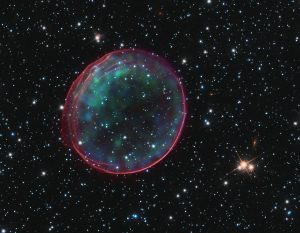Una bolla celestiale

Questo guscio delicato, ripreso dal telescopio Hubble, sembra galleggiare serenamente nelle profondità dello spazio, ma questa calma apparente nasconde un tumulto interiore.
L’involucro gassoso si è formato quando l’onda d’urto in espansione e il materiale espulso da una supernova hanno spazzato il mezzo interstellare circostante. Le osservazioni del telescopio Hubble sono state combinate con immagini a raggi X riprese dall’osservatorio spaziale Chandra.
Chiamata B0509-67.5 SNR (o SNR 0509 in breve), la bolla è il residuo visibile di una potente esplosione stellare nella Grande Nube di Magellano, una piccola galassia a circa 160.000 anni luce dalla Terra. Le increspature nella superficie del guscio possono essere causate sia da leggere variazioni nella densità del gas interstellare circostante, sia eventualmente a frammenti dall’esplosione iniziale. La delicata bolla gassosa si estende per 23 anni luce e si sta espandendo a più di 18 milioni di km/h.
Con un’età di circa 4 secoli, la supernova avrebbe potuto essere visibile nel cielo australe intorno al 1600, anche se non ci sono registrazioni note di una “nuova stella” in direzione della Grande Nube di Magellano a quell’epoca.
[ Barbara Bubbi ]
http://www.spacetelescope.org/images/heic1018b/
Credit: NASA, ESA, the Hubble Heritage Team (STScI/AURA), and NASA/CXC/SAO/J. Hughes
Lascia un commento